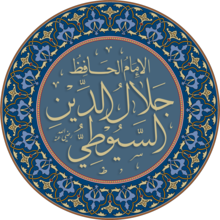
Back جلال الدين السيوطي Arabic السيوطى ARZ جلالالدین سیوطی AZB জালালুদ্দীন সুয়ুতী Bengali/Bangla جەلالەدین سیوتی CKB Džalál ad-Dín as-Sujútí Czech As-Suyūtī German جلالالدین سیوطی Persian Al-Suyūtī French Siyudi Hausa
Al-Suyuti | |
|---|---|
السيوطي | |
 | |
| Title | Shaykh al-Islām[1] Jalal al-Din Al-Ḥāfiẓ |
| Personal | |
| Born | 3 October 1445 CE / 1 Rajab 849 AH |
| Died | 18 October 1505 CE / 19 Jumadi Ula 911 AH |
| Religion | Islam |
| Region | Egypt |
| Denomination | Sunni |
| Jurisprudence | Shafi'i[5][6] |
| Creed | Ash'ari[2][3][4] |
| Main interest(s) | Aqidah, Sharia, Fiqh, Usul al-Fiqh, Hadith, Usul al-Hadith, Tafsir, Arabic grammar, Arabic Literature, Rhetoric, Philology, lexicography, Seerah, History, Mathematics, Medicine |
| Notable work(s) | Tafsir al-Jalalayn, Al-Dur al-Manthur, Al-Itqan fi 'Ulum al-Qur'an, Al-Jami' al-Saghir, Tanbih al-Ghabi bi-Tabri'at Ibn 'Arabi |
| Tariqa | Shadhiliyya |
| Muslim leader | |
Influenced | |
| Arabic name | |
| Personal (Ism) | 'Abd al-Raḥmān |
| Patronymic (Nasab) | ibn Abī Bakr ibn Muḥammad |
| Teknonymic (Kunya) | Abū al-Faḍl |
| Epithet (Laqab) | Jalāl al-Dīn |
| Toponymic (Nisba) | al-Suyūṭī, al-Khuḍayrī, al-Shāfi'ī |
Jalal al-Din al-Suyuti (Arabic: جلال الدين السيوطي, romanized: Jalāl al-Dīn al-Suyūṭī; c. 1445–1505),[8][a] or al-Suyuti, was an Egyptian Sunni Muslim polymath of Persian descent.[9][10] Considered the mujtahid and mujaddid of the Islamic 10th century,[11] he was a leading muhaddith (hadith master), mufassir (Qu'ran exegete), faqīh (jurist), usuli (legal theorist), sufi (mystic), theologian, grammarian, linguist, rhetorician, philologist, lexicographer and historian, who authored works in virtually every Islamic science.[12][13][14] For this reason, he was honoured one of the most prestigious and rarest titles: Shaykh al-Islām.[15]
He was described as one of the most prolific writers of the Middle Ages and is recognized today as one of the most prolific authors of all Islamic literature. Al-Suyuti wrote approximately one thousand works.[16] His biographical dictionary Bughyat al-Wuʻāh fī Ṭabaqāt al-Lughawīyīn wa-al-Nuḥāh contains valuable accounts of prominent figures in the early development of Arabic philology. He was also in his time the leading authority of the Shafi'i school of thought (madhhab).[17]
- ^ Sayyid Rami Al Rifai (3 July 2015). The Islamic Journal From Islamic Civilisation To The Heart Of Islam, Ihsan, Human Perfection. Sunnah Muakada. p. 37.
- ^ "Ahl al-Sunna: The Ash'aris - The Testimony and Proofs of the Scholars". almostaneer.com (in Arabic). Archived from the original on 28 January 2021.
- ^ Spevack, Aaron (2014). The Archetypal Sunni Scholar: Law, Theology, and Mysticism in the Synthesis of Al-Bajuri. State University of New York Press. pp. 99, 179. ISBN 978-1-4384-5371-2.
- ^ In Masalik al-Hunafa' fi Walidayy al-Mustafa, he says: "The Prophet's parents died before he was sent as a Prophet and there is no punishment for them, since (We never punish until We send a messenger (whom they reject)( (17:15 ). Our Ash`ari Imams among those in kalam, usul, and fiqh agree on the statement that one who dies while da`wa has not reached him, dies saved. This has been defined by Imam al-Shafi`i.. . . Some of the fuqaha' explained that the reason is, such a person follows fitra or Primordial Disposition, and has not stubbornly refused nor rejected any Messenger"
- ^ Barakat, E. R., & Haneef, M. A. (2006). "Must Money Be Limited to Only Gold and Silver?: A Survey of Fiqhi Opinions and Some Implications". Journal of King Abdulaziz University: Islamic Economics, 19(1).
- ^ Sookhdeo, Patrick. "Issues of interpreting the Koran and Hadith." Connections 5.3 (2006): 57-82.
- ^ Ali, Mufti. "Aristotelianisme Dalam Kacamata Para Tokoh Abad Tengah Penentang Logika." Al Qalam 24.3 (2007): 318-339.
- ^ Myrne, Pernilla (2018). "Women and Men in al-Suyūṭī's Guides to Sex and Marriage". Mamlūk Studies Review. XXI. The Middle East Documentation Center (MEDOC) at the University of Chicago: 47–67. doi:10.25846/26hn-gp87. ISSN 1947-2404.
- ^ Anna Kollatz; Miri Shefer-Mossensohn; Yehoshua Frenkel; Bethany J. Walker; Toru Miura; Christian Mauder (11 July 2022). The Mamluk-Ottoman Transition Continuity and Change in Egypt and Bilād Al-Shām in the Sixteenth Century, 2. V&R Unipress. p. 268. ISBN 978-3-8470-1152-1.
- ^ Cite error: The named reference
:0was invoked but never defined (see the help page). - ^ Jaleel, Talib (11 July 2015). Notes On Entering Deen Completely Islam as its followers know it. EDC Foundation. p. 1031.
- ^ Zulfiqar Ayub 2015, p. 281
- ^ Esposito, John L. (21 October 2004). The Oxford Dictionary of Islam. Oxford University Press. p. 307. ISBN 978-0-19-975726-8.
- ^ Abul Hasan Ali Hasani Nadwi (30 April 2019). Muslims in India. Claritas Books. p. 36. ISBN 978-1-905837-53-3.
- ^ Ghersetti, Antonella (18 October 2016). Al-Suyūṭī, a Polymath of the Mamlūk Period Proceedings of the Themed Day of the First Conference of the School of Mamlūk Studies (Ca' Foscari University, Venice, June 23, 2014). Brill. p. 44-259. ISBN 978-90-04-33452-6.
- ^ Jere L. Bacharach, Josef W. Meri (31 October 2005). Medieval Islamic Civilization An Encyclopedia. Routledge. p. 784-5. ISBN 978-1-135-45596-5.
- ^ Fancy, Nahyan (3 June 2013). Science and Religion in Mamluk Egypt Ibn Al-Nafis, Pulmonary Transit and Bodily Resurrectio. Taylor & Francis. p. 23. ISBN 978-1-136-70361-4.
Cite error: There are <ref group=lower-alpha> tags or {{efn}} templates on this page, but the references will not show without a {{reflist|group=lower-alpha}} template or {{notelist}} template (see the help page).